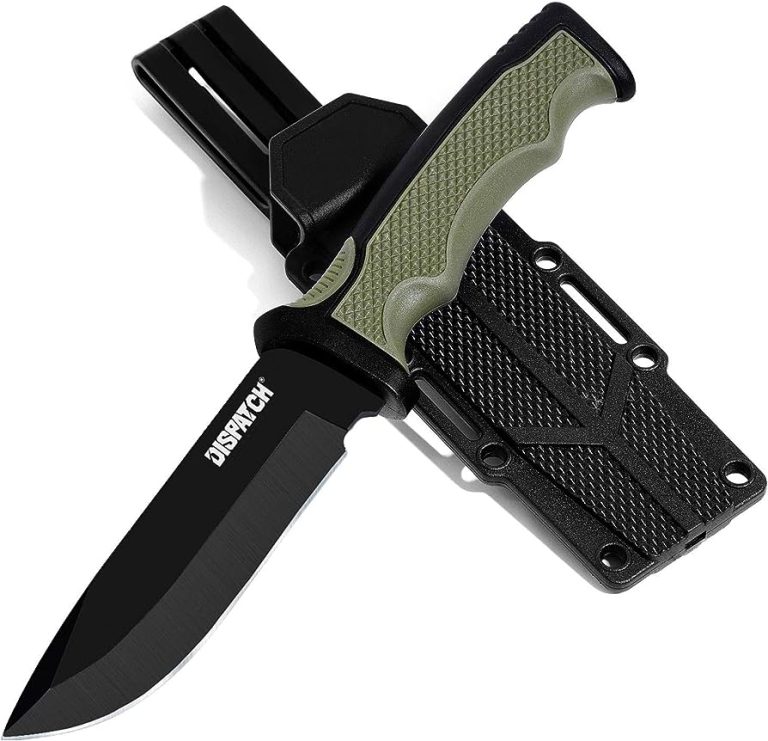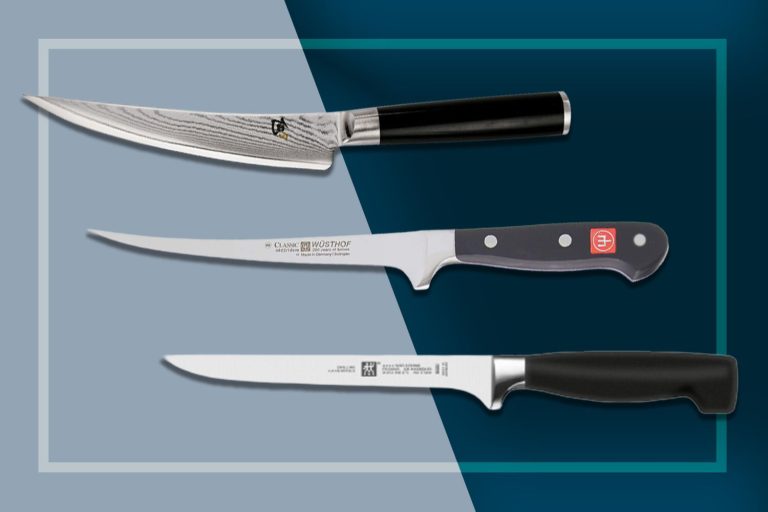The Anatomy of a Kitchen Knife: Blade Types And Uses
A kitchen knife consists of different blade types, each with its specific uses. This article will discuss the anatomy of a kitchen knife, including blade types and their corresponding functions.
A kitchen knife is an essential tool for every chef or home cook. From slicing meat to chopping vegetables, the blade type plays a crucial role in achieving desired results. Different blade types offer unique advantages, allowing for precision, speed, and versatility in the kitchen.
Understanding the anatomy of a kitchen knife will help you choose the right blade type for your culinary needs. This comprehensive guide will explore various blade types commonly found in kitchen knives, such as chef’s knives, paring knives, serrated knives, boning knives, and more. Each blade type serves a specific purpose, making it important to know their uses and strengths. Whether you’re a professional chef or a passionate home cook, having the right blade in your kitchen arsenal can make a significant difference in your cooking experience. So, let’s dive into the diverse world of kitchen knife blade types and their uses.
Chef’S Knife Blade
The chef’s knife blade is the most versatile and essential tool in any kitchen. Its construction and design are crucial in ensuring optimal performance and durability.
Firstly, the blade is typically made of high-quality stainless steel, which provides excellent sharpness and corrosion resistance. The blade is formed using a forging or stamping process, with forged blades known for their superior strength and durability.
The shape of the blade features a curved cutting edge and a pointed tip, allowing for efficient slicing, dicing, and chopping. The length of the blade usually ranges from 6 to 12 inches, providing flexibility for various tasks.
Chef’s knives are widely used for a variety of applications in the kitchen. They are perfect for slicing fruits, vegetables, and meats, as well as mincing herbs and dicing onions. With their well-balanced weight and ergonomic handles, they offer optimal control and comfort during prolonged use.
To sum up, the chef’s knife blade is an indispensable tool in the kitchen, with its construction and design carefully crafted for versatility and ease of use. Whether you are a professional chef or a home cook, a chef’s knife is a must-have for all your culinary adventures.
Santoku Knife Blade
A santoku knife blade is a versatile tool in the kitchen, known for its efficient slicing, dicing, and chopping abilities. Its construction and design make it a popular choice among both professional chefs and home cooks.
The blade of a santoku knife is typically between 5 and 7 inches long, with a straight edge and a hollow edge known as a granton edge. This granton edge helps reduce friction, allowing food to slide off the blade more easily.
Santoku knives feature a wide, flat blade that curves upwards towards the tip, allowing for a rocking motion when cutting. This design makes them ideal for precision tasks like julienning vegetables or thinly slicing meats.
When it comes to uses, the santoku knife excels at handling a variety of tasks in the kitchen. It can be used for slicing fish, dicing onions, or even mincing garlic. Its versatility and sharpness make it an essential tool for any cook.
Paring Knife Blade
The Anatomy of a Kitchen Knife: Blade Types And Uses
Construction and Design
The paring knife is a versatile tool with a narrow, pointed blade that tapers to a sharp tip. Its construction is typically a full tang, where the blade extends throughout the length of the knife and is attached to the handle. This design ensures durability and stability, making it easy to handle for intricate tasks.
Common Uses
- Precision tasks such as peeling fruits and vegetables
- Trimming excess fat from meats and poultry
- Creating garnishes and decorative cuts
Its small size and precise control make the paring knife ideal for intricate and delicate work in the kitchen. Keep a paring knife in your arsenal for those meticulous tasks that require precision and accuracy.

Credit: www.nytimes.com
Serrated Blade
| Serrated Blade |
A serrated blade is a type of kitchen knife blade that features a series of small, scalloped teeth along the edge. In terms of construction and design, this blade typically has a plain edge and the teeth are usually angled or curved. The main purpose of these teeth is to enhance the cutting performance of the knife.
Common uses of a serrated blade in the kitchen include slicing through crusty bread, tomatoes, and other foods with tough exteriors or skins. The saw-like action of the teeth allows for better control and prevents squishing or tearing of the food. Additionally, the serrations help to maintain a sharp cutting edge for a longer period of time compared to a plain edge blade.
Boning Knife Blade
The boning knife blade is an essential tool in any kitchen. Its construction and design are specifically tailored for the task of separating meat from the bone. The blade is typically thin, sharp, and curved, allowing for precise control and maneuverability while removing bones from poultry, fish, and other cuts of meat.
The construction of a boning knife blade involves high-quality stainless steel that ensures its durability and resistance to staining and corrosion. The design includes a pointed tip and a narrow, flexible blade to navigate around joints and bone contours effortlessly. The flexibility of the blade is necessary to glide along the bone surface, minimizing the wastage of meat during the boning process.
As for its common uses, the boning knife is ideal for tasks such as deboning chicken, filleting fish, or removing the silver skin from a tenderloin. Its razor-sharp edge effortlessly cuts through connective tissues and cartilage, making it an indispensable tool for both professional chefs and home cooks.
| Construction and design | The boning knife blade is typically thin, sharp, and curved, allowing for precise control and maneuverability while removing bones from poultry, fish, and other cuts of meat. Made from high-quality stainless steel, it ensures durability and resistance to staining and corrosion. The pointed tip and narrow, flexible blade navigate around joints and bone contours effortlessly. |
| Common uses | The boning knife is ideal for deboning chicken, filleting fish, or removing the silver skin from a tenderloin. Its razor-sharp edge cuts through connective tissues and cartilage with ease, making it indispensable for professional chefs and home cooks alike. |
Fillet Knife Blade
A Fillet Knife Blade is a type of kitchen knife blade that is specifically designed for filleting fish. The construction and design of a fillet knife blade are essential for achieving precise and clean cuts. It typically has a thin, flexible, and tapered blade, which allows for easy maneuverability around bones and joints.
This type of knife blade is commonly used by professional chefs and home cooks for filleting, skinning, and de-boning fish. The thin and flexible blade allows for the removal of the skin and separation of the meat from the bones with ease.
The construction of a fillet knife blade is usually made from high-quality stainless steel, ensuring durability and ease of maintenance. The design often includes a handle that provides a comfortable grip, allowing for better control and reducing the risk of accidents during use.
Overall, a Fillet Knife Blade is an essential tool for anyone who regularly works with fish, enabling them to achieve precise and effortless filleting results.
Factors To Consider
Factors to consider when choosing a kitchen knife include the blade material, blade length, and blade shape.
The blade material plays a crucial role in determining the knife’s performance, durability, and maintenance. Stainless steel is a popular choice due to its rust resistance and ease of cleaning. Carbon steel offers excellent sharpness and edge retention, but requires more maintenance to prevent rust.
The blade length determines the knife’s versatility and ease of use. Shorter blades provide better control and maneuverability for precision tasks like peeling and trimming. Longer blades are ideal for slicing and chopping larger ingredients.
The blade shape also influences the knife’s functionality. A chef’s knife, with a curved blade and pointed tip, is versatile and suitable for various tasks. A paring knife, with a straight edge and pointed tip, excels in intricate tasks like peeling and trimming. A serrated blade is commonly used for slicing bread and delicate items like tomatoes.
Blade Maintenance And Care Tips
The proper maintenance and care of your kitchen knife blades is crucial to ensure their longevity and optimal performance. Here are some essential tips:
- Proper cleaning techniques: **Clean** the blade immediately after use with **warm soapy water** and a non-abrasive sponge or cloth. **Avoid using harsh chemicals** or abrasive materials that can damage the blade’s surface.
- Sharpening and honing: Regularly **sharpen** your knife using a **whetstone** or a **knife sharpener** to maintain its sharpness. **Honing** the blade with a honing rod should be done before or after each use to straighten the edge and keep it aligned.
- Storage recommendations: Store your knives in a **knife block**, on a **magnetic strip**, or in a **knife sheath** to protect the blade from damage and prevent accidents. **Never** store knives loosely in a drawer, as it can lead to dulling and accidents.
By following these simple maintenance and care tips, you can ensure that your kitchen knife blades remain sharp, durable, and safe to use.
Conclusion
To wrap up, understanding the different blade types and their uses is crucial for anyone looking to equip their kitchen with the right knives. From everyday tasks like slicing and dicing to specialized techniques like filleting or chopping herbs, each blade type serves a unique purpose.
The chef’s knife, versatile and efficient, is a staple for any home cook. The serrated blade comes in handy when tackling crusty bread or juicy tomatoes. A paring knife is a great companion for intricate tasks like peeling or trimming.
The boning knife excels at separating meat from bones, while the slicing knife ensures thin, uniform cuts every time. By harnessing the power of this knowledge, home cooks can elevate their culinary experience and truly excel in the kitchen. So, next time you’re shopping for kitchen knives, keep in mind the anatomy of a knife and choose the right blade types for your needs.
Happy cooking!






